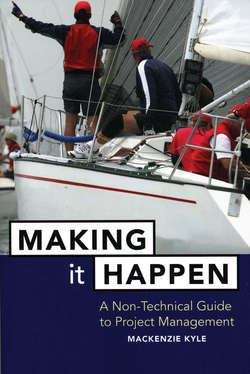Читать книгу Making It Happen - Kyle Mackenzie - Страница 7
Part One
Genesis
2
Grasping the Scope
ОглавлениеBefore I left his office, Stu provided more details about the WindSailor.
The WindSailor board was made from a relatively new fiberglass resin compound, and because of this the board needed to be painted with a special sealant that required a longer than normal curing time. Since I don’t know a great deal about the chemistry of reinforced plastics (or any chemistry at all), this didn’t mean much to me until Stu told me that this would place constraints on our manufacturing facility. Specifically, we would have to provide extra warehouse space for the curing process. This space had to be part of, or connected to, the manufacturing space. The boards could not be transported very far, and certainly not outside, after they had been sealed.
According to Leslie Frame in marketing, who had been in Europe working with the WaterTrends people, we expected to sell about 2,600 WindSailors in the first year, at a price of about $1,600 each. Although that meant only a ten percent sales increase at Hyler, Leslie was projecting sales of almost $10 million by the third year. That represented a significant chunk of money for the company.
The Europeans had introduced the WindSailor in only a few geographic areas in late July, having missed their first-of-the-season target date by a wide margin (my ears pricked up when I heard that), so they did not have much marketing data to go on. The response in those selected areas, however, had been impressive. Their initial run of 2,500 boards sold out within four weeks, and they had back orders for next year equal to three-quarters of their production capacity. They were increasing their capacity to meet what they hoped would be an even greater demand next season.
Leslie estimated that by purchasing the North American manufacturing and distribution rights to the WindSailor, Stu had given Hyler a least a full year’s head start on any North American competition, and on other European manufacturers who might try to export to our market. Since this was a brand-new product, Leslie figured that this head start would give us market dominance over any competing boards for as much as three years, more if our marketing and promotion efforts were done well.
There was, of course, a catch that Stu seemed almost happy to relate. Leslie and the WaterTrend folks in Germany figured it would take the competition about 16 to 18 months to design, test, and produce a board that would get around the WindSailor patent protection and compete head to head with our product.
“So you see,” said Stu, “we have to get our WindSailor into the marketplace before the end of next summer.” It was now August. “That leaves you almost ten months. No problem!” He actually reached across the desk and slapped me on the shoulder.
No problem. Design the new facility, build it, buy all the equipment, and get it running properly in less than ten months. As I thought about this, I became even more appreciative of the fact that we were located near Portland, where it does not snow and you can do construction work all year.
Our distribution system always pushes our production dates back earlier than you would expect. Hyler owns only one retail outlet, and it is located at our plant. The rest of our product is sold through a variety of privately owned sporting goods stores. This means our products have to be ready for sale well before the final customer wants to buy them. Distribution time is a reality that has to be factored into all of our production schedules. To get the WindSailor out to the public for, say, the last part of next summer, we would have to have it ready for sale by June. This would allow adequate time to get it out to retailers.
